Neglect
Working Together defines neglect as:
“The persistent failure to meet a child’s basic physical and/or psychological needs, likely to result in the serious impairment of the child’s health or development. Neglect may occur during pregnancy as a result of maternal substance abuse.
Once the child is born, neglect may involve a parent or carer failing to:
- provide adequate food, clothing and shelter;
- protect a child from physical and emotional harm or danger;
- ensure adequate supervision (including the use of inadequate care-givers); or
- ensure access to appropriate medical care or treatment.
It may also include neglect of, or unresponsiveness to, a child’s basic emotional needs.”
Neglect is the most common and widespread form of child abuse. Currently in England 48% of all child protection plans are under the category of neglect and in 60% of child safeguarding practice reviews neglect is known to be a factor.
It is pervasive and its effects can have long-term consequences for the child’s development and outcomes; but it can be the most difficult form of child abuse to recognise.
Neglect can be very difficult to notice as having one of the signs doesn’t mean that a child is experiencing neglect. Also it generally involves an omission and failure to do something rather than an intentional act and this can sometimes make it difficult for professionals to recognise neglectful parenting.
The standards of care against which neglect is measured are:
- meeting the child’s basic physical needs
- promoting their health
- providing age-appropriate supervision, boundaries and guidance
- providing emotional warmth and support and good family relationships
- promoting the child’s educational development and achievement.
So you need to be alert to when there are signs that these standards are not being effectively met, such as:
- Poor physical appearance – a child who is dirty, hungry, has a lack of appropriate clothing, bad hygiene, not having access to medical care and treatment
- Poor home conditions – dirty or hazardous conditions, lack of a safe place to play, inadequate or unsuitable sleeping arrangements, young people excluded from the family home
- Behavioural signs – developmental delay, failure to thrive, poor self-esteem, aggression, withdrawal, social isolation, substance misuse, running away, non-attendance at school
- Absence of supervision/boundaries – a child who is put in danger or not protected from physical harm, use of inadequate care givers, chaotic family environment with no boundaries or routines
- Failing to support their health and/or medical needs – missed health or dental appointments, failure to comply with medical advice and give medications or treatment appropriately, delayed or missed immunisations.
Knowing the signs of neglect can help to give a voice to children. Any child can suffer neglect, although some may be more vulnerable than others. Children more vulnerable include those who are born prematurely, have a disability or have complex health needs, are in care, or are seeking asylum.
When families go through a tough time (e.g. experiencing relationship problems, financial hardship, poverty, mental health issues, addiction or bereavement), parents or carers may struggle to maintain the standards of care for their child. That’s why it’s important to have a conversation with them using the Family Support tools to work with parents and carers to ensure their getting the support they need in order to be able to care for their children.
Although you may be worried about a child, it’s not always easy for professionals to identify neglect. There’s often no single sign or incident that a child or family need help. It is more likely that there will be a series of concerns over a period of time that, taken together, demonstrate the child is at risk. If you think neglect is occurring in a family, household or for an individual child or young person don’t wait:
- Discuss concerns with the child, parent / carer and family members as appropriate
- Discuss concerns with colleagues and partner agencies
- Use the Family Support tools to guide your questions, observations and areas for further consideration
- Record concerns, conversations and interaction
- Use a chronology
- Regularly review progress using these tools and update the Family Support Plan accordingly
The Neglect Practice Guidance has been developed to support you with more information on how you can identify neglect and what your response should be.
Worried about a child – If you are concerned that a child or young person has suffered harm, neglect or abuse, please contact
Portsmouth Multi Agency Safeguarding Hub (MASH)
If a child is at immediate risk of harm, call the Police on 999
Day in the Life Tools can help you to work with children and families to make sense of an individual’s lived experience. The model aims to help practitioners gain a better understanding of what is happening in families where neglect is an issue and what actions may lead to improved outcomes for children.
There are six versions of the “day in my life” tool, each specifically written for the following cohorts of children:
- Day in the Life – Unborn baby
- Day in the Life – Baby
- Day in the Life – Pre-school child
- Day in the Life – Primary school aged child
- Day in the Life – Adolescent
- Day in the Life – Child with disabilities
We have also produced this guide to give more information on how to use these tools.
- Neglect (to follow)
